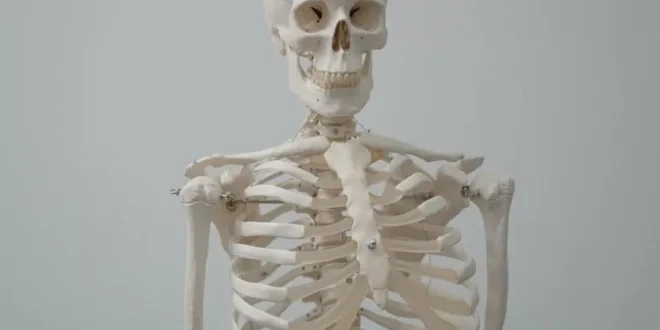While we often associate weight with our overall body mass, have you ever wondered how much does the human skeleton weigh?
The human skeleton, an intricate framework of bones, serves as the structural support system for our bodies.
Every day, we rely on our skeleton to carry us through life, providing strength, stability, and protection.
Yet, many of us seem to have limited knowledge about the skeleton besides its support structure.
If you find the topic on the skeleton amusing, you are in the right place; continue reading to the end. We’ll start our discussion on the interesting topic by answering the question, how much does the human skeleton weigh?
So, How Much Does The Human Skeleton Weigh?
The human skeleton of an adult weighs around 10 -11 kg, around 14-15% of the total body. Bone mass will reach its maximum when an individual ages 25-30 years old. An individual might have a heavier skeleton due to fats.
Are Bones Alive?
The answer is yes; bones are very much alive. Bones are made up of living tissues that continuously undergo a process of growth, repair, and remodeling throughout an individual’s life.
Bones contain blood vessels, nerves, and cells that enable them to perform their functions effectively.
Like other organs in the body, the blood brings food and oxygen into the bones and then excretes the waste products from the bones.
The bone cells known as osteocytes help to maintain bone density and strength by regulating the amount of calcium and other minerals in the bone.
Functions Of The Human Skeleton
Beyond its structural role, the skeletal system performs a multitude of functions that are vital for our overall well-being, and this includes.
1. Support the body
The skeleton offers the body a framework that supports and maintains its shape. Without the skeleton, you would be a lean mass of skin, muscle, and organs.
2. Protects internal body organs
The skeleton houses the body’s internal organs protecting them from external forces that might damage them. A good example is the rib cage, which protects our delicate lungs and heart.
Without it, the lungs will collapse, and the heart will lack enough room to perform its functions properly. Additionally, the skull protects our delicate brains, which control our behaviors and movement and interprets our senses.
Crucial vessels carrying blood at high pressure to vital organs are deep within the bones.
3. Mineral storage
Bones store your body’s mineral supply, such as vitamin D and calcium. The skeleton incorporates these minerals in its tissues, and they can easily get back into the bloodstream to support physiological processes.
An example is calcium ions which are responsible for muscle contraction and also control the flow of other ions the body needs in nerve impulse transmission.
4. Facilitates movement
The joints connecting bones facilitate the free movement of the body, with some bones allowing for a wider range of movement than others.
Pivot joints like the neck allow for a shorter movement than the ball and socket joints. The movement will occur with the rhythmical contraction and relaxation of skeletal muscles attracted to the bones. The central nervous system coordinates the bone, muscles, and joints.
5. Endocrine Regulation
Bone cells produce a hormone, Osteocalcin, which significantly impacts blood sugar regulation and fat deposition.
The hormone increases insulin sensitivity and secretion and boosts the production of insulin-producing cells.
6. Blood cell production
The bone produces vital blood cells such as red blood cells (RBC), white blood cells (WBC), and platelets.
RBCs are essential for transporting oxygen to the body’s tissues in exchange for carbon dioxide, which the lungs expel.
The red bone marrow is responsible for red blood cell formation in a process called hematopoiesis.
Nonetheless, the bone marrow also produces white blood cells responsible for developing the body’s immune response. Platelets are responsible for the formation of clots on injured parts of the body, preventing blood loss.
Factors Affecting Skeletal Weight
Many factors influence the weight of the human skeleton, and understanding them is essential in comprehending the dynamics of skeletal weight and its impact on overall bone health. Here are some of the factors that will determine your skeletal weight.
1. Age
Age is a great determinant of a person’s skeletal weight. The skeleton starts to grow from birth, and some bones fuse to make stronger bones. That is why a baby has more bones than an adult.
As one approaches 25-30 years, they will achieve their skeletal’s maximum mass. However, this mass starts to reduce as the individual starts getting older.
Human bones lose their mass and density with age due to the loss of calcium and other minerals.
2. Sex
Sex is another determinant of a person’s skeletal weight. Women tend to have a lighter skeletal (especially after menopause) as they age than men. Men possess a skeletal that adapts better to aging than women.
3. Use of supplements
Intake of supplements with minerals such as calcium could affect skeletal weight. Calcium is a great determinant of bone health and weight.
If the bone loses calcium, it will begin to lose its weight. Taking a calcium supplement boosts the build of calcium in the skeleton, giving it more weight.
4. Genetics
A person’s genetics is also a great contributor to their skeletal weight. If your family tree does not have a history of medical conditions concerning the skeletal, then you will likely have a normal skeletal weight.
However, if your family has a history of medical conditions concerning the bones, such as osteoporosis, you might have a lighter skeleton. Osteoporosis is when the skeletal becomes fragile and brittle from tissue loss, and one can inherit it genetically.
5. Nutrition
The body relies on food for energy to properly carry out its processes. Proper nutrition increases a person’s bone density making their skeletal heavy. However, lack of proper nutrition means that the skeletal will not have a normal weight.
It is why it is imperative to have a balanced diet, as it will help build essential minerals in the skeletal.
6. Physical activities
Physical activities not only strengthen the muscles but also the bones. Structures of the body that one uses often become more powerful.
As one engages in physical activity, the body adapts and allocates more calcium to the bones to strengthen them.
Conversely, one who does not engage in physical activity will not develop stronger bones. The body does not see the significance of solid and heavy bones as the individual rarely uses them.
7. Lifestyle
Lifestyle covers everything you do in your everyday life from the moment you wake up to the moment you retire to bed. Be conscious of the choices you make every day concerning what you do, eat, drink, and how often.
For example, a lifestyle involving a lot of activity and healthy eating will lead to healthier and heavy bones.
A lifestyle with an unhealthy diet and many surgeries, such as weight loss, could affect the body’s ability to absorb calcium, hence, lighter bone.
Division Of The Skeleton
In humans, the skeletal system is made up of 206 named bones that can be classified into two major divisions: axial skeleton and appendicular skeleton.
The axial skeleton consists of 80 bones that form the body’s central axis. It includes the skull bones, vertebral column, ribs, and sternum.
The axial skeleton supports and protects vital organs such as the brain, spinal cord, and heart.
On the other hand, the appendicular skeleton comprises 126 bones that support the limbs and their attachments to the axial skeleton.
The appendicular skeleton consists of free appendages, such as the upper and lower limbs and their attachments, known as girdles. The appendicular skeleton plays a crucial role in movement, locomotion, and balance.
Interesting Facts About Human Joints, Muscles, And Bones
- Smiling requires 17 muscles while frowning requires the use of 43 muscles.
- Approximately 31% of the composition of your bones is made up of water.
- Over 600 muscles make up the human body.
- About one man in 20 possesses an extra rib.
- During growth, several bones in our body fuse, reducing from over 300 bones at birth to 206 bones in adulthood.
- The collective weight of the muscles in our body accounts for about 40% of our total body weight.
- The human skull consists of a total of 22 bones.
- During puberty, bones cease to grow in length, although bone density and strength continue to evolve throughout a person’s lifetime.
- The jawbone is the hardest bone in the human body.
- The human skeleton undergoes a renewal process approximately once every three months.
- The femur, also known as the thigh bone, is the longest bone in our body, accounting for approximately a quarter of an individual’s height.
Conclusion
Understanding how much does the human skeleton weigh is an excellent step towards an exciting journey of exploring the human body. Bones have living tissues that undergo a never-ending growth, repair, and remodeling process.
Therefore, a person’s skeleton weight will vary throughout their lifetime, even as adults. Bones have essential functions, such as offering support and blood cell production. Nonetheless, nutrition and genetics are one of the many factors that affect skeletal weight.
 Being Human
Being Human





